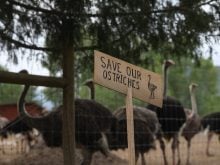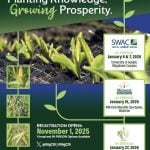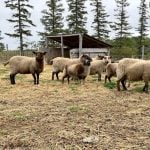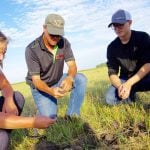If it weighs, reads, calculates, indicates or otherwise communicates on the farm and is modern and electronic, then it probably is computerized.
That means when the bell tolls on New Year’s Day 2000, some 400-odd days from now, automated equipment on the farm may stop working if it is not attended to.
Barbara Warner of the Canadian Federation of Agriculture’s year 2000 project said farmers should start preparing now.
“We are telling farmers the first thing they should do is a walk about. Take note of everything that’s computerized. Look at all the equipment and anywhere there is digital output there is potential problem.”
Read Also

Farming Smarter to hold Agronomy Battles series
Southern Alberta non-profit research institute hope grassroots sessions with producers help focus future research on cover crops, strip tillage and herbicide resistance
Most farm computers used to keep accounts, access the internet or manage poultry barns will escape serious problems but a few, mainly because of the software that runs them, will fail. New software should fix most problems.
Some older personal computers, IBM compatibles, have built-in clocks that cannot be reset and must have a small chip replaced. Others will have to be manually set for the year 2000.
Test your system
A software program, Ymark2000, is available free from National Software Testing Laboratories in Pennsylvania. The program tests PCs and renders a verdict on whether they will be able to cope with the new millennium, a term known as Y2K compliant.
Software companies, especially larger ones, have posted Y2K information on their websites that list software that might fail, as well as possible solutions.
Many farmers and small businesses rely on spreadsheet programs to keep books and production records. Nearly all of these programs can accommodate the year 2000 if given the proper instructions.
Changing the date pattern in the computer’s clock so it accepts a four-digit year instead of only the last two digits, which was standard until recently, will fix most problems. The date pattern can usually be changed in the setup or preferences.
More serious computer problems are located in less obvious places – inside little black chips, laboring silently in the dark, that communicate with other little black chips in a web of circuits and switches.
It is this relationship between components that can cause more serious problems. A tiny computer asks simple questions such as ‘what is the date?’ and ‘when was the last safety service?’
The answers are just as simple. ‘the date is 00 and does not compute’ or ‘it is 1900 and this is a malfunction.’
If in turning to the year 2000, the two-digit year code reads the date as 01/01/00, the machine could assume it has never been serviced and is unsafe or inaccurate or about to fail.
It could respond by shutting down.
An inventory of computing devices on the farm can save money and grief.
Richard Cantin, of Ontario Dairy Herd Improvement, said his organization has been testing the computer system used by more than 1,000 Ontario dairy farmers to record and track their production.
“We’ve been assured by the manufacturer that our program is (Y2K) compliant. Even so we’ll be testing it in advance to be sure about it. As farmers they have to be sure they can rely on this stuff.”
The Ontario agriculture department has placed a checklist on the internet with details about items that should be checked.
Producers should start with an inventory of all hardware and software and save it somewhere other than on their computers.
The inventory should include farm equipment with digital readouts and monitoring systems. Weighing equipment, especially items that record and print information, and barn management computers should all be checked to make sure they are Y2K compliant.
After making a list of potential trouble spots, farmers should contact equipment suppliers and ask if the product or service will be affected by the millennial date change.
Feed suppliers and other services farmers rely upon should be contacted and asked if they have a Y2K plan in place and if they guarantee service after the end of 1999. Buyers that regularly take delivery of fresh produce or livestock should be contacted to ensure they will continue accepting deliveries for the period shortly after the clock strikes 2000.
Agriculture Canada’s Y2K site, (www.agr.ca/policy/y2k/) suggests producers ensure that contracts with suppliers or buyers state who is responsible for which aspects of Y2K compliance.
New equipment bought between now and the end of 2001 should have Y2K responsibilities stated in the sales agreement.
Other websites available
Several internet websites could help farmers navigate a course though potential Y2K problems.
- IBM’s site is www.ibm.com/ibm/year2000/.
* National Software Testing Laboratories site, which makes a
- National Software Testing Laboratories site, which makes a
program to test for year 2000 compliance, is located at www.nstl.com/html/nstl_y2k_main.html.
- Corel can be found at www.corel.com/2000.htm.
- Microsoft provides help at support.microsoft.com.
* Patrick O’Beirne’s spreadsheet site, which offers free advice to
- Patrick O’Beirne’s spreadsheet site, which offers free advice to
spreadsheet users, is www.iol.ie/sysmod/y2ksprds.htm.
- The Ontario government’s list is located at www.gov.on.ca/omafra/english/infores/year2000/checklist.html.














